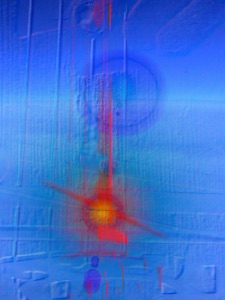Petal 004
Cellitude
Jean-Baptiste Barrière : composition, electronics & images conception
Anssi Karttunen, cello
Pierre-Jean Bouyer, images realization
Cellitude was conceived as a performance prolongation of the installation Autoportrait in Motion, part of the Reality Checks cycle. The version of Cellitude proposed for the " enhanced-cd ", is a film realized specially for this medium from the same materials the the original performance.
In the Autoportrait in motion installation, people encounter their image in the electronic mirror and discover worlds somehow hidden in or behind the mirror.
In Cellitude, it is the cellist, Anssi Karttunen, who goes to the encounter of his own image, visual but also auditory, reflected by the electronic mirror.
This dramaturgy gives the piece its form, and constitutes a pretext to a kind of investigation of the cello identity. Investigation which moves from introspective to spectacular characteristics, microscopic to macroscopic study of some of the many sides of this polymorphic and unseizable instrument.
In this piece, the character of the cellist, in front of the mirror, is bringing out, by his playing, images and sounds hidden behind the mirror, including the voice of a Japanese woman, Tamami Tonno, reciting an ancient poem.
The text comes from a collection of the French poet Jacques Roubaud (Mono no aware, Gallimard, 1970), and is read in its original Japanese version, at the same time as in French (by myself) in the version of Roubaud. « Puisque je pense que le réel n'est réel en rien, comment saurais-je que les rêves sont rêves ? » (Since I think that the real is real in no ways, how could I know that dreams are dreams?).
The choice of the voice materials is motivated by its pure foreign character to the cello, as well as by its theme which corresponds perfectly to the spirit of Reality Checks.
It is by discovering these materials through his playing, that the cellist reveals his identity. From difference, identity is born. The dramatic character is progressively defined by the set up and the confrontation between the two protagonists: the cellist and his electronic reflection. The reflection first imitates the cellist, as a slave of his gestures, and then frees itself and develops an autonomous discourse. This discourse is enigmatic and unpredictable, escapes from the cellist, and therefore, because of its extreme difference, brings him back to the very question of his own identity. This question is bound to remain without a definitive answer.
Cellitude was commissioned by Peter Révai for the Migros Foundation and the Gegenwart Museum of Zürich, and was premiered there on March 2nd, 1998. The piece was realized with the help for the musical part of Frédéric Voisin, and for the visual part of Isabelle Barrière (camera and regie) and Pierre-Jean Bouyer (processing of images). It is dedicated, naturally, to Anssi Karttunen.
Jean-Baptiste Barrière

